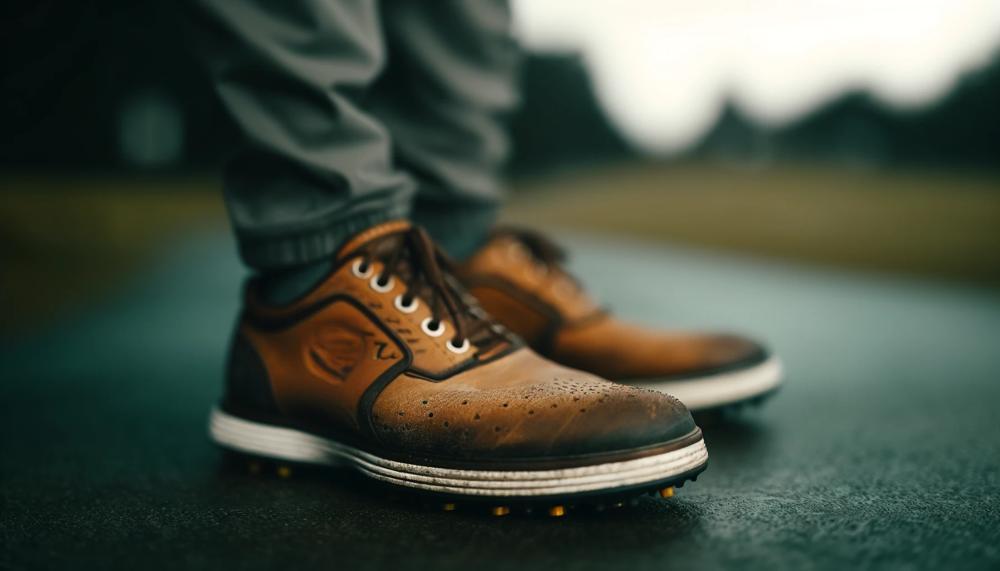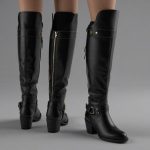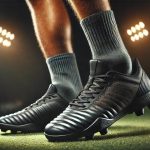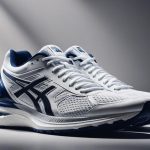Choosing the right shoes for caddying isn’t just a matter of comfort—it’s about ensuring you can perform your best on the course.
As a caddy, you’ll be walking long distances, carrying heavy bags, and navigating a variety of terrains. The correct footwear can prevent fatigue, enhance stability, and keep you going strong throughout the day.
Key Points We’ll Cover:
- Comfort: Why cushioning and arch support are non-negotiable for reducing fatigue and preventing injury.
- Traction: The importance of good grip on grass, sand, and other terrains to prevent slips and falls.
- Durability: How investing in high-quality shoes can save you money and discomfort in the long run.
- Weather Resistance: Why waterproof and breathable materials are essential for dealing with different weather conditions.
- Popular Choices: A look at top brands and models favored by caddies for their superior design and functionality.
Wearing the right shoes can make a significant difference in your caddying experience. Whether you prefer traditional golf shoes or more casual sneakers, finding the perfect pair that offers support, stability, and comfort is key to thriving on the course. Ready to discover the best options out there? Let’s dive in.
Best Shoes For Caddying?
Contents
- 1 Best Shoes For Caddying?
- 2 Choosing the Right Style for Caddying Shoes
- 3 Top Brands for Caddying Shoes: FootJoy, Adidas, Skechers
- 4 Factors to Consider When Choosing Caddying Shoes: Durability and Weather Resistance
- 5 The Benefits of Arch Support and Cushioning in Caddying Shoes
- 6 Traction and Stability: Key Features in Caddying Shoes
- 7 How to Determine the Best Fit for Caddying Shoes
- 8 Conclusion
Choosing the best shoes for caddying involves several crucial factors to ensure comfort, stability, durability, and functionality. Here’s a detailed look at what to consider:
| Factor | Description | Example Features |
| Comfort | Comfort is paramount for caddies who spend long hours walking and standing. Look for shoes with cushioned insoles, good arch support, and padded collars to reduce foot fatigue and provide maximum comfort. | Memory foam insoles, EVA midsole, padded tongue |
| Stability | Stability is essential for navigating various terrains on a golf course. Shoes with good traction and support can prevent slips and provide balance, especially when carrying heavy golf bags. | Rubber outsole with deep treads, spikeless traction |
| Durability | Caddying can be tough on shoes, so choose pairs made from high-quality materials that can withstand frequent use and various weather conditions. | Leather or synthetic leather upper, reinforced stitching |
| Waterproofing | Weather conditions can be unpredictable, making waterproof or water-resistant shoes vital to keep feet dry and comfortable during rainy days. | Gore-Tex lining, sealed seams |
| Breathability | Breathable shoes help keep feet cool and dry, reducing the risk of blisters and discomfort in hot weather. | Mesh panels, perforated uppers |
| Proper Fit | Ill-fitting shoes can cause injuries and discomfort. Ensure a proper fit by trying on shoes before purchasing and looking for adjustable features like laces or straps. | Lace-up closure, adjustable straps |
| Weight | Lightweight shoes reduce fatigue, especially important when carrying heavy golf bags for extended periods. | Lightweight materials like mesh or synthetic fabrics |
| Style | While functionality is key, stylish shoes that look good on the course can also be important. Choose shoes that offer both performance and aesthetic appeal. | Modern designs, colour options |
Choosing the Right Style for Caddying Shoes
Choosing the right style of shoes for caddying hinges on four pivotal factors: functionality, durability, comfort, and support.
Each plays a critical role in ensuring that caddies can perform their duties effectively and comfortably throughout a day on the golf course.
| Factor | Description | Importance |
| Functionality | Shoes must be made from durable, breathable materials with a strong grip. | Essential for effective movement and terrain navigation. |
| Durability | Constructed from high-quality materials, suited to outdoor or golf-specific activities. | Ensures shoes withstand the daily wear and tear of caddying. |
| Comfort | Features like padded insoles and supportive midsoles for long-lasting comfort. | Key for maintaining comfort during long hours on the course. |
| Support | Good arch and ankle support, potentially enhanced with shock absorption. | Prevents injuries and provides stability on uneven grounds. |
By prioritizing these aspects, caddies can select shoes that will not only keep them comfortable but also bolster their performance on the golf course.
Top Brands for Caddying Shoes: FootJoy, Adidas, Skechers
| Brand | Key Features | What Sets Them Apart |
| FootJoy | Superior comfort, traction, durability, spiked and spikeless options | Use of advanced D.N.A. technology for optimal comfort and stability. |
| Adidas | Supportive, excellent traction, designed with golfers in mind | Innovation in sustainability, use of recycled materials, ongoing technology enhancements. |
| Skechers | Lightweight, comfortable, focuses on flexibility and stability | Combines affordability with quality, appealing to budget-conscious caddies. |
FootJoy stands out with their longstanding commitment to quality, evident in their utilisation of D.N.A. technology, ensuring caddies can walk comfortably for hours.
Adidas elevates their game by integrating sustainability with their design philosophy, using recycled materials while maintaining performance standards.
Skechers enters the scene with an approach centred on delivering uncompromised quality at a more accessible price point, proving a hit among caddies looking for economic options without sacrificing comfort.
Factors to Consider When Choosing Caddying Shoes: Durability and Weather Resistance
Durability and weather resistance are critical factors when selecting the best shoes for caddying due to the demanding nature of the job.
Caddies traverse various terrains and face unpredictable weather, necessitating footwear that can endure extensive use and protect against the elements.
| Factor | Importance | Details |
| Durability | High |
|
| Weather Resistance | High |
|
Choosing shoes with these attributes ensures that caddies can perform their duties effectively, regardless of the weather or ground conditions. This combination of durability and weather resistance makes for a reliable, comfortable, and long-lasting shoe, enhancing the caddy’s overall experience on the golf course.
The Benefits of Arch Support and Cushioning in Caddying Shoes
The importance of arch support and cushioning in caddying shoes primarily revolves around the specific needs of walking and standing for extended periods on varied golf course terrains. While arch support is generally noted not to improve running economy, the context of caddying is quite different from running.
Caddying involves significant amounts of walking and occasional sprints, often on soft, uneven grounds. Here, arch support can help distribute weight more evenly, potentially reducing foot fatigue and preventing overuse injuries.
Cushioning plays a dual role in enhancing comfort and minimizing impact stress. Courses are not uniformly flat or hard; thus, caddies benefit from shoes that can absorb the shock of walking on varied surfaces. A softer shoe decreases the energy return, which, while potentially reducing running efficiency, actually aids in reducing fatigue over long durations by offering a gentler impact with each step.
Here’s a detailed comparison table highlighting the effects of arch support and cushioning on caddying performance:
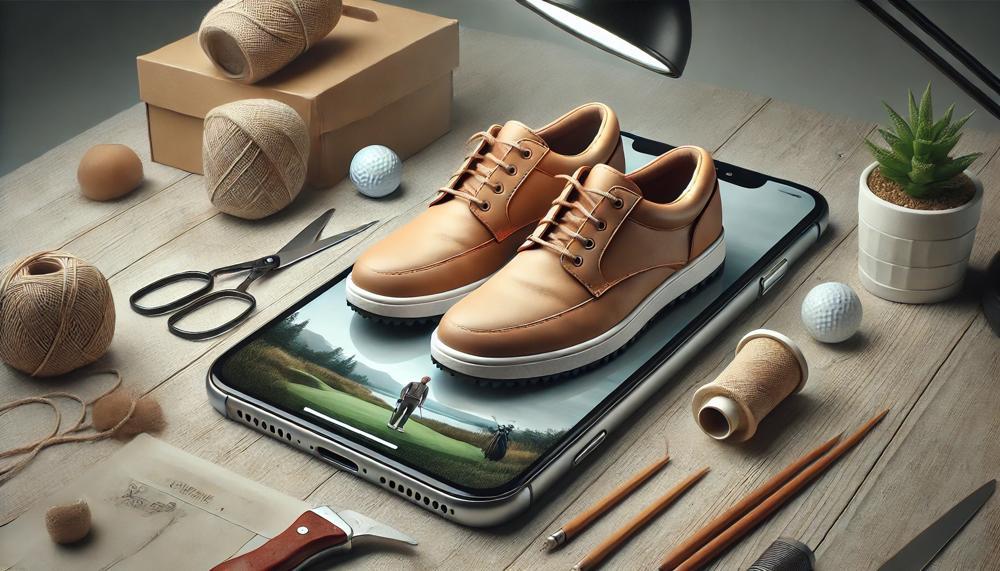
| Feature | Benefit | Application in Caddying |
| Arch Support | Improves weight distribution | Reduces foot fatigue during long rounds of walking |
| Cushioning | Minimizes impact stress | Comfort on varied terrain; reduces joint strain |
For caddies, who spend hours on their feet, these shoes are not just about endurance but also about maintaining peak physical condition throughout the game. Arch support ensures that the foot’s natural arches are supported, preventing conditions like plantar fasciitis.
Meanwhile, cushioning absorbs shocks that could otherwise lead to joint pain and fatigue, ensuring that the caddy’s mobility is not compromised.
Traction and Stability: Key Features in Caddying Shoes
Traction and stability are paramount when selecting shoes specifically tailored for caddying on the golf course. Here, we discuss the essential features that contribute to the effectiveness of these shoes in ensuring both safety and performance during the game.
Key Features to Consider:
- Sole Design: The tread pattern on the sole of the shoe is critical for traction. Look for soles with deep, wide-spaced lugs that can grip the turf without clogging with dirt or grass, essential for maintaining stability on varied terrains.
- Material: Rubber soles are preferable due to their durability and ability to provide excellent grip on wet and slippery surfaces. High-quality rubber ensures that the shoes will not only last longer but also perform better in different weather conditions.
- Midsole Technology: Shoes that feature advanced midsole technologies like EVA (ethylene-vinyl acetate) or polyurethane provide better shock absorption and stability. This is crucial for caddies who spend hours walking and standing, as it helps in reducing foot fatigue and enhancing comfort.
- Waterproofing: To ensure that the shoes perform well in all conditions, waterproofing is a must. This feature helps keep the feet dry in dewy morning rounds or during rainy weather, which is vital for maintaining traction and avoiding slips.
- Fit and Support: A well-fitted shoe with good arch support and cushioning is essential. Proper fit prevents unnecessary movement inside the shoe that could lead to blisters or instability while moving across the course.
- Flexibility: While stability is important, the shoes should also offer some flexibility to adapt to different terrains without restricting the foot’s natural movement.
Visual Representation of Shoe Features:
| Feature | Description | Benefit |
| Sole Design | Deep, wide-spaced lugs | Enhanced grip and stability on grass |
| Material | High-quality rubber | Long-lasting, superior traction in wet conditions |
| Midsole Technology | EVA or polyurethane | Shock absorption, reduces foot fatigue |
| Waterproofing | Essential for all conditions | Keeps feet dry, maintains traction |
| Fit and Support | Good arch support and cushioning | Prevents internal movement, enhances comfort |
| Flexibility | Allows natural foot movement | Adapts to varied terrains |
By selecting caddying shoes with these key features, one can ensure both traction and stability, which are critical for maneuvering through the diverse challenges a golf course presents.
How to Determine the Best Fit for Caddying Shoes
To ensure the best fit for caddying shoes, you should take into account several critical elements that impact both comfort and performance on the golf course. Here’s a step-by-step guide:
Measure Your Feet Properly
- Always have your feet measured professionally, especially late in the day when they are largest due to natural swelling.
Consider the Shoe Type and Features
- Opt for shoes designed specifically for golf caddying, which offer stability and flexibility. Look for shoes with ample cushioning, arch support, and a secure fit around the midsole to prevent your foot from shifting inside the shoe.
Material and Weather Suitability
- Choose materials that suit the climate you’ll be working in. For wet conditions, a waterproof upper is essential, while breathable fabrics are better for hot weather.
Traction and Grip
- Consider the type of sole based on the terrain. Rubber or spiked soles enhance grip and stability on varied surfaces like grass, sand, or wet ground.
Try Before You Buy
- Always try on shoes with the socks you intend to wear. Walk around to ensure there’s no pinching or slipping. The best time to try on new shoes is in the afternoon or evening, when your feet are at their largest.
Check for Adequate Room
- Ensure there’s about a thumb’s width between the front of the shoe and your longest toe, and that there is enough room to wiggle your toes without restriction.
Conclusion
Selecting the right shoes for caddying is essential for optimal performance on the golf course. As a caddy, you’ll traverse long distances, carry heavy bags, and navigate various terrains. Proper footwear not only ensures comfort but also enhances stability and durability, making your job more manageable and enjoyable.
Comfort is paramount. Cushioned insoles, good arch support, and padded collars reduce foot fatigue and prevent injuries. Equally important is traction. Shoes with a strong grip prevent slips and falls, allowing you to move confidently across grass, sand, and other surfaces. Durability is another key factor. High-quality shoes, though often more expensive, can withstand the rigors of frequent use and varied weather conditions, ultimately saving money and discomfort.
Weather resistance is crucial. Waterproof and breathable materials keep your feet dry in the rain and cool in the heat, ensuring comfort regardless of the weather. Popular choices among caddies include brands like FootJoy, Adidas, and Skechers, known for their superior design and functionality.
In conclusion, investing in the right shoes can significantly improve your caddying experience. Prioritize comfort, stability, durability, and weather resistance to stay strong and efficient throughout your day on the course.

